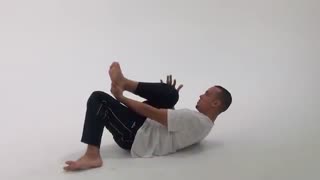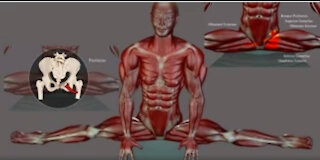Psoas Test Which Hip Flexors Are Tight Paul Zaichik l EasyFlexibility l ElasticSteel
Hip flexors misconceptions. Today I am going to talk about some misconceptions about hip flexors flexibility testing even among the professionals.
The standard approach to find out if the “Psoas” is tight is to some how make sure that the Rectus Femorus isn’t (tight).
It’s like having 10 people in the room, and someone boke a vase. You assume if it’s not person 1, it has to be person 10. What about person 2-9 ? Why couldn’t they have done it?
Same goes for the “Tight Psoas” Test.
I see physical therapists, massage therapists, fitness trainers place a person on the table in supine position. Table ends under the knees, so that the lower leg hands off the table.
They ask them to pull one knee into the chest.
They assume that if the hamstrings rise off the table with bent knee, the culprit is the rectus femoris. And if the knee extends and the hamstrings moves lower to the table, it’s Psoas.
The problem with that test is that, just because it’s not the rectus femoris, does not mean that it’s psoas.
Simply because everyone heard of Psoas, does not mean that it’s guilty.
There are other muscles that can prevent hip joint from extending. Tensor Fascia latae, Pectineus, Sartorius, even Psoases best bud, the Illiacus. Adductors Also flex the hip, but unless there is a serious issue, we can exclude them if the legs are adducted.
The problem is, even if Psoas is tight indeed, one will try to stretch the Psoas by either dropping the leg off the table (usually with bent knee), which goes against the (if the leg is bent, it’s the rectus femoris that is tight) principle.
OR doing a lunge stretch, which can get multiple muscles in one shot and if any of them are tighter than Psoas, they will block the Psoas from being stretched.
So how does one stretch the Psoas or any other muscle without having another muscle(s) get in a way?
Here is the answer. Every muscle is unique. Every muscle does something different. For example there is no other muscle that does what Psoas does. Same way there is no other muscle that has the same actions as pectineus,sartorius, TFL, etc
Knowing the kinesiology of the body, (Zaichik Stretching Technique, formerly known as Kinesiological Stretching Techniques is based on the science of kinesiology) allows to isolate each muscle and stretch it separately.
Often practitioners spend a long time stretching a muscle, with a technique that does not actually stretch it and they get no results.
If you are interested in a very unique Hip Flexors Program, see it here.
https://www.easyflexibility.com
-
 0:36
0:36
Stretching Made Easy
3 years agoEasyFlexibility By Break Dance Instructor and Performer BBoy Lego
87 -
 2:46
2:46
ElasticSteel
3 years agoWinter Workout Warm Up Injury Prevention l Paul Zaichik l ElasticSteel l EasyFlexibiity
40 -
 1:54
1:54
Stretching Made Easy
3 years agoPsoas Stretch Release Stretches For Psoas Kinesiological Stretching EasyFlexibility
61 -
 3:28
3:28
EasyFlexibility
3 years ago $0.01 earnedSide Splits Straddle Stretching Exercise Anatomy EasyFlexibility Muscle Diagram ElasticSteel
178 -
 0:21
0:21
thomasefallon
3 years ago $0.01 earnedWhich one
431 -
 0:16
0:16
jason152
3 years agoWhich toy
15 -
 0:03
0:03
GrovenaGrowers
3 years agoTight squeeze
40 -
 0:10
0:10
TellyWells
3 years agoWhich is bestest
40 -
 1:57
1:57
Stretching Made Easy
3 years agoEasyFlexibility Kinesiological Stretching Workshops Announcement
61 -
 1:32
1:32
KGTV
3 years agoTight security ahead of Inauguration
9299